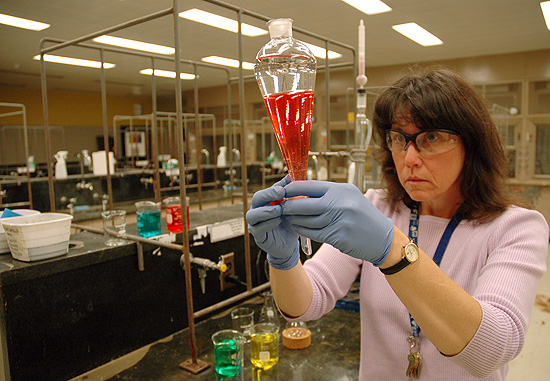Chemistry Lab Has New Environmental Perspective
 |
| Andrea Roberts, visiting instructor of chemistry, has introduced “green” techniques into her organic chemistry laboratory sections. Students use fewer chemicals, producing less waste. |
| Posted 06/20/07 |
| At first glance, Wesleyans Organic Chemistry Laboratory doesnt appear much different to the naked eye. But a closer look shows that virtually everything in the lab has changed.
Were going green, says Andrea Roberts, visiting instructor of chemistry and Ph.D candidate. Were promoting sustainability and teaching the leaders of tomorrow better ways to do chemistry. Roberts started teaching the organic chemistry lab in Spring 2004, using a routine syllabus. The class had nine weeks of typical organic reaction labs and one, three-week final project. The Chemistry Department had been teaching the same organic chemistry curriculum for years, Roberts says. Some of the organic reactions students were doing were the same ones I did as an undergraduate. Although they were tried and true, they were becoming outdated. Very few industries nowadays are performing chemical reactions the way we were teaching them, and our experiments were producing a tremendous amount of chemical waste. In Spring 2007, Roberts made changes to the curriculum that allowed her to teach the same material using greener methods. This meant minimizing materials chemicals, solvents and testing equipment; reusing or recycling materials in the lab; replacing harmful mineral acids and organic solvents with less toxic oxidants like peroxide and alcohols as solvents ultimately minimizing waste. She began with the lab titled Introduction to Chromatography. For this task, students needed to separate a mixture of two compounds, fluorene and fluorenone. Students previously used a gravity-based technique called column chromatography to separate and purify the chemical compounds. This slow method required .5 grams of fluorene and fluorenone to pass through a tube, or column, of 10 grams of silica gel. About 200mL of hexane was used to separate the compounds. Roberts replaced this old-fashioned method with flash chromatography, a rapid method that pumps solvent through a cartridge, leading to quicker separations with less chemical waste. She replaced the fluorene and fluorenone with drops of water-soluble food coloring and used only .75 grams of silica, which later is recycled. Only 10mL of isopropyl alcohol is used, rather than hexane. Roberts is able to recycle used silica gel in-house. As a result, no solid waste is generated in this experiment and only 10mL of alcohol is output as liquid waste. Experiments with organic chemistry, a branch of chemistry that focuses on the properties and reactions of carbon-containing compounds, have the potential to be bad for the environment, explains Bill Nelligan, associate director of Environmental Health and Safety. By going green, Nelligan estimates the lab has reduced its solid and liquid waste by 50 percent each. According to EPA guidelines, waste must be documented and discarded properly. These chemicals are sent to EPA-permitted Treatment Storage and Disposal Facilities for disposal or to be used as fuel in energy conversion plants. Wesleyan owns all chemicals, from the time they are brought into the university, to the time they are used, and from the time they are recycled or end up in a hazardous waste facility or landfill, Nelligan explains. Chemicals are a cradle to grave responsibility. Roberts began the quest to go green in Summer 2006 when she met with Margaret Kerr, who received her inorganic chemistry Ph.D. from Wesleyan in 1998. Kerr is currently an assistant professor of inorganic chemistry at Worchester State College and an expert on green chemistry. Kerr directed Roberts to the online database, Greener Education Materials for Chemists. This site features an interactive collection of chemistry education materials focused on green chemistry. I was able to find the same lessons using green chemistry and plug them into our curriculum, Roberts says. Organic Chemistry Laboratory is a required course for anyone majoring in chemistry or pre-medical, dental and veterinary studies. The updated, environmentally-friendly course, CHEM 258, has increased student enrollment 25 percent over the last few years. Roberts teaches six sections comprising no more than 20 students each. By going green, Wesleyan is taking part in the U.S Environmental Protection Agencys Green Chemistry Program. Green Chemistry Program has built hundreds of collaborations with academia, industry, government agencies, scientific societies, trade organizations, national laboratories and research centers to promote the use of chemistry for pollution prevention through completely voluntary, non-regulatory partnerships. Next fall, Roberts will co-teach the laboratory-based Integrated Chemistry course Chem 375 with Albert Fry, professor of chemistry. Roberts plans to introduce green chemistry concepts to the lab. If we just focus on being one university going green, in one state, in one country, we are doing our part, Roberts says. Wouldnt it be wonderful if every university in every state did their part? Imagine the impact. |
| By Olivia Drake, The Wesleyan Connection editor |

